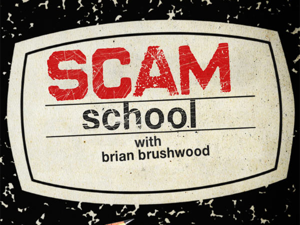 This week's Scam School features yet another creation by Martin Gardner, as submitted by yours truly!
This week's Scam School features yet another creation by Martin Gardner, as submitted by yours truly!
This one is a prediction, but one that is very clean and appears very fair to your audience. It's also a handy impromptu effect to know, since it's adaptable to so many different props.
In this week's episode of Scam School, this routine is performed simply with paper, pens, and coasters:
This routine was created by Martin Gardner, who originally published it in Ibidem #6, back in 1956, as The 1-2-3 Trick. These days, it's more easily found in Martin Gardner Presents under the same name.
There's one important part to this routine that is underemphasized in the video above, and I'd like to focus on that here.
As described in the video, there are two possibilities. The first one is the possibility that occurred in the performance part of the video, where the Ms, the Bs, and the Hs all matched.
The 2nd possibility, revealed with the prediction on the paper, is the possibility I'll be discussing in more detail. Take a close look at the second possibility (about 6:30 into the video) - the left column (from top to bottom) reads MBH, the second column (again, from top to bottom) reads BHM, and the 3rd column (yes, from top to bottom) reads HMB. Notice that each of these groups has no duplicates in it, so that each forms a complete set of 3. This will always be true for 1 of the 2 possibilities in this routine.
In Martin Gardner's original version of the trick, he used Aces, 2s, and 3s of three different suits, and specifically refers to this to the audience as The 1-2-3 Trick.
Imagine it playing out this way: You set down the Ace of Hearts, 2 of Hearts, and 3 of Hearts as the middle row of cards, and after laying down your arrangement, the cards appear in this manner:
2 3 A
A 2 3
If they lay it down 2, 3, A (reading from left to right), then you've got the first possibility. If they lay it down the only other possible way, you have the 2nd possibility:2 3 A
A 2 3
3 A 2
Now, every column contains an Ace, a 2, and a 3! Here is where you take advantage of stating the name earlier. You say, "Remember, before I started, when I referred to this as the The 1-2-3 Trick? Here's why it's called that. The first (leftmost) column contains the 1 (Ace), my 2, and your 3! The middle column contains your 1 (Ace), the 2, and my 3! Finally the remaining column features my 1 (Ace), your 2, and the 3! Each column contains 1-2-3!"There are two very important points that should be emphasized in this presentation, when it comes to the 2nd possibility. First, the fact that the spectators are reminded that you apparently stated the nature of the routine up front makes your prediction very puzzling, especially as they are unaware that you were ready for a completely different possibility, and that there really is only 1 other possibility.
The 2nd psychological point is that the more you can build something up as a group of 3, the better you can cover the 2nd possibility. Brian mentions using the 3 Stooges, which lets you start with the rather amusing opening, "Have you ever seen the Larry, Curly, and Moe trick?" You could just as well use Harry, Ron, and Hermione, or any other famous group of 3 in which all 3 individuals or objects work as a group and are individually identifiable. For example, the Three Blind Mice wouldn't make a good theme, as they are rarely identified individually.
Think about what this means. Surprisingly, there's no need to write down a 2nd prediction whatsoever! When performed as in Martin Gardner's original manner, both predictions come across as equally organic and equally plausible, especially when you emphasize the name of the routine at the beginning with all 3 players. This, together with the fact that such a wide variety of props can be employed, makes it a handy trick that surprisingly strong when performed correctly.
Note: If you're wondering about the title to this post, it's a sort of sequel to the other four posts where Grey Matters was mentioned in Scam School - Scam School Meets Grey Matters, Scam School Meets Grey Matters...Again!, Scam School Meets Grey Matters...Yet Again! and Scam School Meets Grey Matters...Still Yet Again!. You can also see the Grey Matters episodes of Scam School via my YouTube playlist, Mathematics: Scam School meets Grey Matters.




2 Response to Scam School Meets Grey Matters V
Using cards with the names "Tom, Dick and Harry" is an idea. Ideal perhaps for the second outcome possibility?
That's a perfect example of a great presentation idea!
Perfect opening line: "Have you ever seen the Tom, Dick & Harry trick? No? I thought I'd shown this to every Tom, Dick & Harry..."
Post a Comment